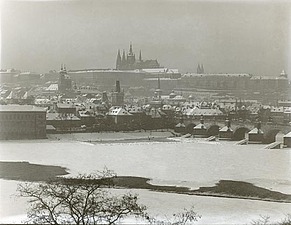Prague Castle in the Years 1900-1939
Aside from the transformation of the seat of kings into a presidential residence, the famous authors captured also the transformation of the photography itself.
Photos of Prague Castle in the Years 1900–1939
By the end of the 19th century, some photographers had abandoned descriptive photos and rather accentuated the mood of the shot. They found support in refined pigment processes that linked photography to graphic art, thus also suggesting the relations of the new medium to the acknowledged fields of art. Before World War I first attempts were made at capturing Prague Castle with the use of colour photograph-autochrome technique. However, a more frequent way of supplying photos with colour was coloration. The projections of lucid pictures, as the colour slides were called, included the subject theme of Prague Castle, were very popular thanks to its symbolism.
After the establishment of an independent republic, which also resulted in the transformation of Prague Castle into the seat of the president, photography likewise underwent some changes and the mood character of the various shots gradually vanished. The new times also brought with them efforts at more systematic photographic documentation. The importance of photography and its increasing use in the press were reflected in the rise of many agencies: the Czechoslovak Press Office and the Castle Photo-Archive were established. As regards the documentation of the Castle, the most important agency was the Press Photo Service. Likewise, the Construction Management of Prague Castle – an office established in 1919 to help the Office of the President – also provided photo-documentation of the Castle during the reconstruction works, which could serve the national heritage institutions, too. Apart from the documentary and reporting roles, photography was exploited for publicity purposes, related to the symbolical part played by Prague Castle – both at home and abroad. A number of photo-postcards were produced, but also photos used in pictorial publications and magazines, which were on the upswing and constituted another element in spreading photographs.
At the turn of the 1920s, the change in viewing photography was distinct. Promoting the programme of sharply outlined images, factuality, an interest in details and in new views from unusual angles and stands, the new generation of photographers also included others, who sought social themes. Views from above, from below or those emphasising the diagonal, all this influenced even ordinary photographers in reports. The symbolical culmination of the century-long development of photography was an exhibition entitled A Centenary of Czech Photography in 1939, which was perhaps the most extensive show of this kind worldwide, presenting photography from all possible angles and including both contemporary and historical works. A hundred-year period of the greatest search by photographers thus symbolically ended.
(Překlad: Kateřina Hilská )
By the end of the 19th century, some photographers had abandoned descriptive photos and rather accentuated the mood of the shot. They found support in refined pigment processes that linked photography to graphic art, thus also suggesting the relations of the new medium to the acknowledged fields of art. Before World War I first attempts were made at capturing Prague Castle with the use of colour photograph-autochrome technique. However, a more frequent way of supplying photos with colour was coloration. The projections of lucid pictures, as the colour slides were called, included the subject theme of Prague Castle, were very popular thanks to its symbolism.
After the establishment of an independent republic, which also resulted in the transformation of Prague Castle into the seat of the president, photography likewise underwent some changes and the mood character of the various shots gradually vanished. The new times also brought with them efforts at more systematic photographic documentation. The importance of photography and its increasing use in the press were reflected in the rise of many agencies: the Czechoslovak Press Office and the Castle Photo-Archive were established. As regards the documentation of the Castle, the most important agency was the Press Photo Service. Likewise, the Construction Management of Prague Castle – an office established in 1919 to help the Office of the President – also provided photo-documentation of the Castle during the reconstruction works, which could serve the national heritage institutions, too. Apart from the documentary and reporting roles, photography was exploited for publicity purposes, related to the symbolical part played by Prague Castle – both at home and abroad. A number of photo-postcards were produced, but also photos used in pictorial publications and magazines, which were on the upswing and constituted another element in spreading photographs.
At the turn of the 1920s, the change in viewing photography was distinct. Promoting the programme of sharply outlined images, factuality, an interest in details and in new views from unusual angles and stands, the new generation of photographers also included others, who sought social themes. Views from above, from below or those emphasising the diagonal, all this influenced even ordinary photographers in reports. The symbolical culmination of the century-long development of photography was an exhibition entitled A Centenary of Czech Photography in 1939, which was perhaps the most extensive show of this kind worldwide, presenting photography from all possible angles and including both contemporary and historical works. A hundred-year period of the greatest search by photographers thus symbolically ended.
(Překlad: Kateřina Hilská )































